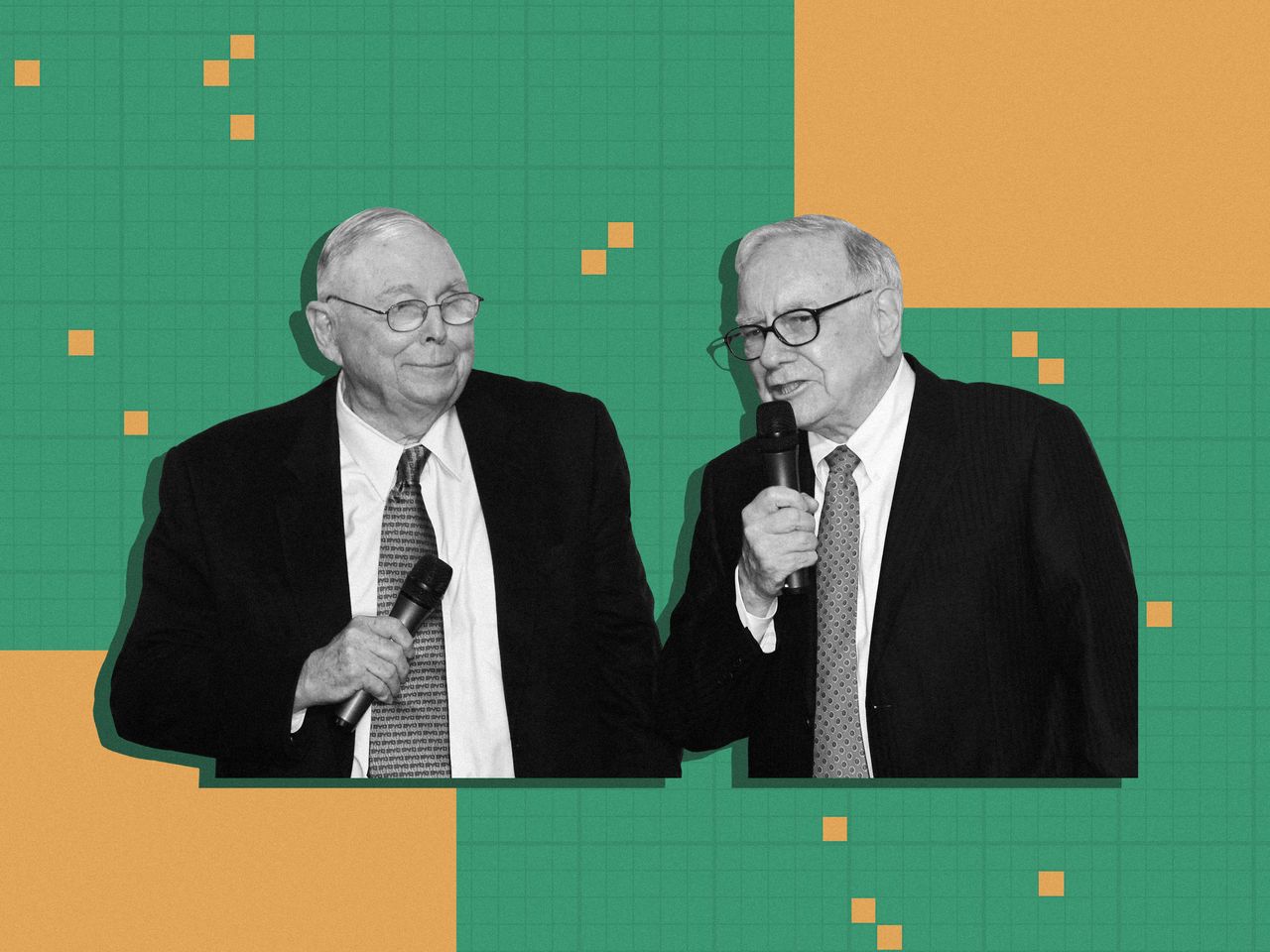Keep the Ambition, Lower Your Ego. How to Thrive as a No. 2 Like Charlie Munger.
Warren Buffett’s longtime deputy showed that rising to the top isn’t everything
Charlie Munger was Robin to Warren Buffett’s Batman, a business equivalent of the Edge rocking with the Bono of investing.
Munger, who died Tuesday at age 99, played one of the toughest roles in the corporate (or any) world: No. 2.
Succeeding as second in command takes a rare blend of confidence and humility, say people who’ve done it. The consummate right-hand person must be devoted to organizational success while accepting that someone else’s star will always shine brighter.
At a time when many American workers are reconsidering whether the race to the top is worth running at all, Munger’s apparent satisfaction with being the ultimate sidekick could be a model.
It helped that Warren and Charlie, as the duo was known, shared a personal friendship. And being a wingman is presumably more fun when you’re a billionaire, as Munger was. Most important, say those who knew him: Munger knew he was respected and appreciated.
Buffett made sure of it.
Harry Kraemer, former chief executive of the healthcare company Baxter International, recalls a conversation with Buffett at a CEO gathering around the year 2000: “I said, ‘Boy, you’ve got an amazing track record.’ And he goes, ‘It isn’t just me. Never mention my name without Charlie’s.’”
In a recent annual letter, Buffett wrote: “I never have a phone call with Charlie without learning something.”
There aren’t many pairs like Buffett and Munger. An analog might be the late Canadian telecom mogul Ted Rogers and his longtime lieutenant, Phil Lind, who died in August at age 80. Robert Brehl, who co-wrote Lind’s 2018 memoir, “Right Hand Man,” says loyalty is essential to a relationship like Rogers-Lind or Buffett-Munger.
Having complementary strengths and interests helps ward off resentment, Brehl adds.
“You have to have the yin and yang,” he says. “Ted wouldn’t have been as effective without Phil, and the same thing with Warren and Charlie.”
Before meeting Buffett, Munger was already a professional success. He served in World War II, went to Harvard Law School and co-founded a law firm, Munger, Tolles & Olson, where his name was first on the door.
Even though his results as an investor were strong, over time, he realised he could be more successful—and happier—in a partnership. Understanding his own shortcomings contributed to his willingness to become Buffett’s running mate, he has said. He rejected Buffett’s initial overtures before agreeing to come aboard.
“It took me a long time to wise up that [Buffett] had a better way of making a living than I did,” Munger told CNBC in 2021. “But he finally convinced me that I was wasting my time.”
Not that it was easy to set aside his ego to take the No. 2 role and play to what his No. 1 needed. Buffett was Berkshire Hathaway’s public face and larger-than-life persona. Munger seemed to relish his freedom from talking to reporters and investors. In the background, he could be sharper, more direct and funnier.
The durability of the Buffett-and-Munger duo act stemmed, in part, from a shared intellectual curiosity, a measure of humility—for billionaires, anyway—and willingness to learn from their mistakes.
“I constantly see people rise in life who are not the smartest, sometimes not even the most diligent, but they are learning machines,” Munger said in his commencement address to the University of Southern California’s law school in 2007. “They go to bed every night a little wiser than they were when they got up and, boy, does that help, particularly when you have a long run ahead of you.”
Savvy runners also know it can be best to let someone else take the lead to break the wind. A certain type of person prefers to run second, says social psychologist Tessa West, who is studying people she calls “runners up” for a forthcoming book.
“Once you get to a certain level of power, you realise that that top position doesn’t necessarily come with more influence—it just comes with more publicity and a lot more reputational risk,” she says. “The way I see it, Munger got to have his cake and eat it too. He had status without all the headaches.”
He also had a life outside of Berkshire and Buffett. One of Munger’s pet projects was a quest to design the perfect college dormitory.
He’ll be remembered as the consummate consigliere, but that wasn’t his whole identity.
—Geoffrey Rogow contributed to this article.
 Copyright 2020, Dow Jones & Company, Inc. All Rights Reserved Worldwide. LEARN MORE
Copyright 2020, Dow Jones & Company, Inc. All Rights Reserved Worldwide. LEARN MORE
This stylish family home combines a classic palette and finishes with a flexible floorplan
Just 55 minutes from Sydney, make this your creative getaway located in the majestic Hawkesbury region.
Impact investing is becoming more mainstream as larger, institutional asset owners drive more money into the sector, according to the nonprofit Global Impact Investing Network in New York.
In the GIIN’s State of the Market 2024 report, published late last month, researchers found that assets allocated to impact-investing strategies by repeat survey responders grew by a compound annual growth rate (CAGR) of 14% over the last five years.
These 71 responders to both the 2019 and 2024 surveys saw their total impact assets under management grow to US$249 billion this year from US$129 billion five years ago.
Medium- and large-size investors were largely responsible for the strong impact returns: Medium-size investors posted a median CAGR of 11% a year over the five-year period, and large-size investors posted a median CAGR of 14% a year.
Interestingly, the CAGR of assets held by small investors dropped by a median of 14% a year.
“When we drill down behind the compound annual growth of the assets that are being allocated to impact investing, it’s largely those larger investors that are actually driving it,” says Dean Hand, the GIIN’s chief research officer.
Overall, the GIIN surveyed 305 investors with a combined US$490 billion under management from 39 countries. Nearly three-quarters of the responders were investment managers, while 10% were foundations, and 3% were family offices. Development finance institutions, institutional asset owners, and companies represented most of the rest.
The majority of impact strategies are executed through private-equity, but public debt and equity have been the fastest-growing asset classes over the past five years, the report said. Public debt is growing at a CAGR of 32%, and public equity is growing at a CAGR of 19%. That compares to a CAGR of 17% for private equity and 7% for private debt.
According to the GIIN, the rise in public impact assets is being driven by larger investors, likely institutions.
Private equity has traditionally served as an ideal way to execute impact strategies, as it allows investors to select vehicles specifically designed to create a positive social or environmental impact by, for example, providing loans to smallholder farmers in Africa or by supporting fledging renewable energy technologies.
Future Returns: Preqin expects managers to rely on family offices, private banks, and individual investors for growth in the next six years
But today, institutional investors are looking across their portfolios—encompassing both private and public assets—to achieve their impact goals.
“Institutional asset owners are saying, ‘In the interests of our ultimate beneficiaries, we probably need to start driving these strategies across our assets,’” Hand says. Instead of carving out a dedicated impact strategy, these investors are taking “a holistic portfolio approach.”
An institutional manager may want to address issues such as climate change, healthcare costs, and local economic growth so it can support a better quality of life for its beneficiaries.
To achieve these goals, the manager could invest across a range of private debt, private equity, and real estate.
But the public markets offer opportunities, too. Using public debt, a manager could, for example, invest in green bonds, regional bank bonds, or healthcare social bonds. In public equity, it could invest in green-power storage technologies, minority-focused real-estate trusts, and in pharmaceutical and medical-care company stocks with the aim of influencing them to lower the costs of care, according to an example the GIIN lays out in a separate report on institutional strategies.
Influencing companies to act in the best interests of society and the environment is increasingly being done through such shareholder advocacy, either directly through ownership in individual stocks or through fund vehicles.
“They’re trying to move their portfolio companies to actually solving some of the challenges that exist,” Hand says.
Although the rate of growth in public strategies for impact is brisk, among survey respondents investments in public debt totaled only 12% of assets and just 7% in public equity. Private equity, however, grabs 43% of these investors’ assets.
Within private equity, Hand also discerns more evidence of maturity in the impact sector. That’s because more impact-oriented asset owners invest in mature and growth-stage companies, which are favored by larger asset owners that have more substantial assets to put to work.
The GIIN State of the Market report also found that impact asset owners are largely happy with both the financial performance and impact results of their holdings.
About three-quarters of those surveyed were seeking risk-adjusted, market-rate returns, although foundations were an exception as 68% sought below-market returns, the report said. Overall, 86% reported their investments were performing in line or above their expectations—even when their targets were not met—and 90% said the same for their impact returns.
Private-equity posted the strongest results, returning 17% on average, although that was less than the 19% targeted return. By contrast, public equity returned 11%, above a 10% target.
The fact some asset classes over performed and others underperformed, shows that “normal economic forces are at play in the market,” Hand says.
Although investors are satisfied with their impact performance, they are still dealing with a fragmented approach for measuring it, the report said. “Despite this, over two-thirds of investors are incorporating impact criteria into their investment governance documents, signalling a significant shift toward formalising impact considerations in decision-making processes,” it said.
Also, more investors are getting third-party verification of their results, which strengthens their accountability in the market.
“The satisfaction with performance is nice to see,” Hand says. “But we do need to see more about what’s happening in terms of investors being able to actually track both the impact performance in real terms as well as the financial performance in real terms.”
This stylish family home combines a classic palette and finishes with a flexible floorplan
Just 55 minutes from Sydney, make this your creative getaway located in the majestic Hawkesbury region.






















